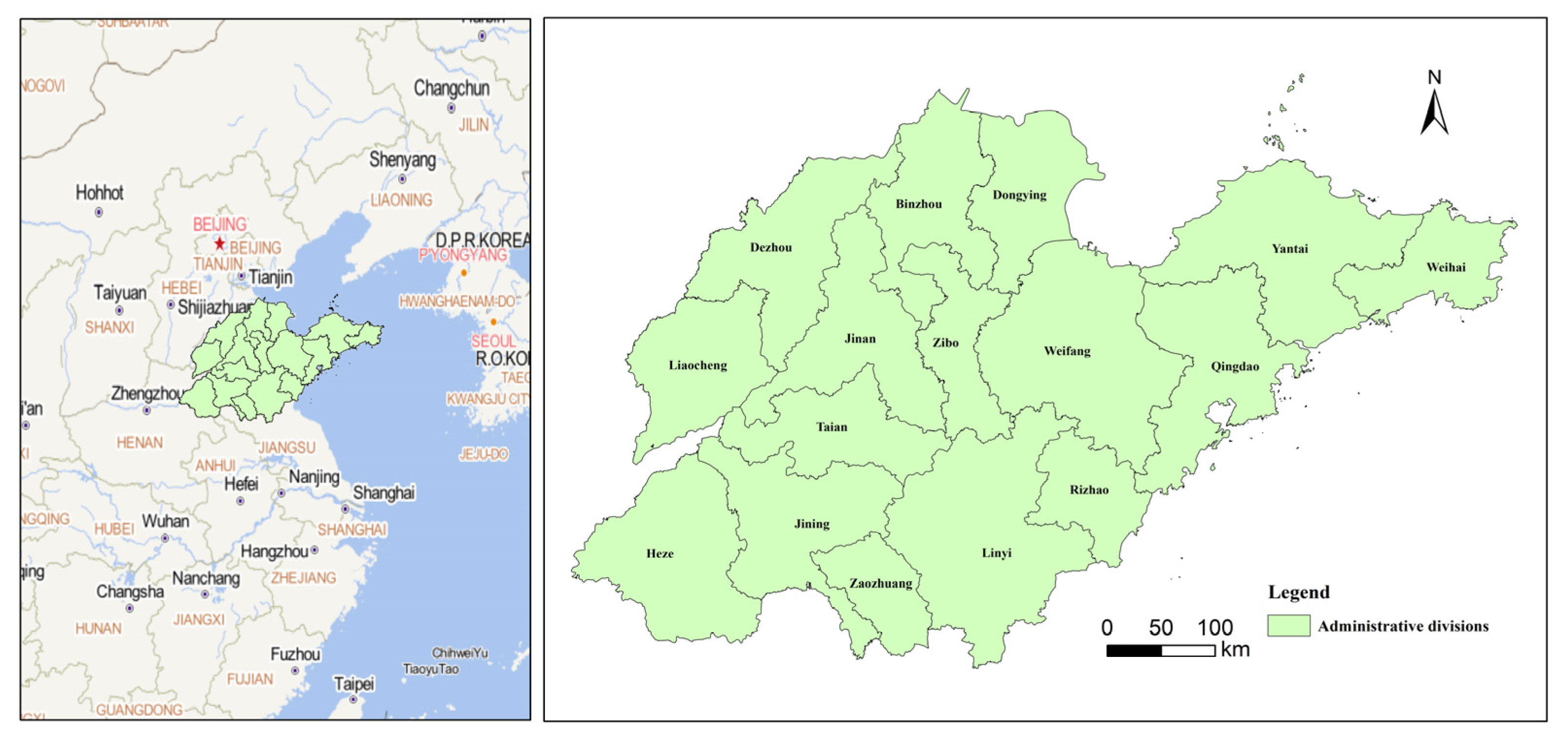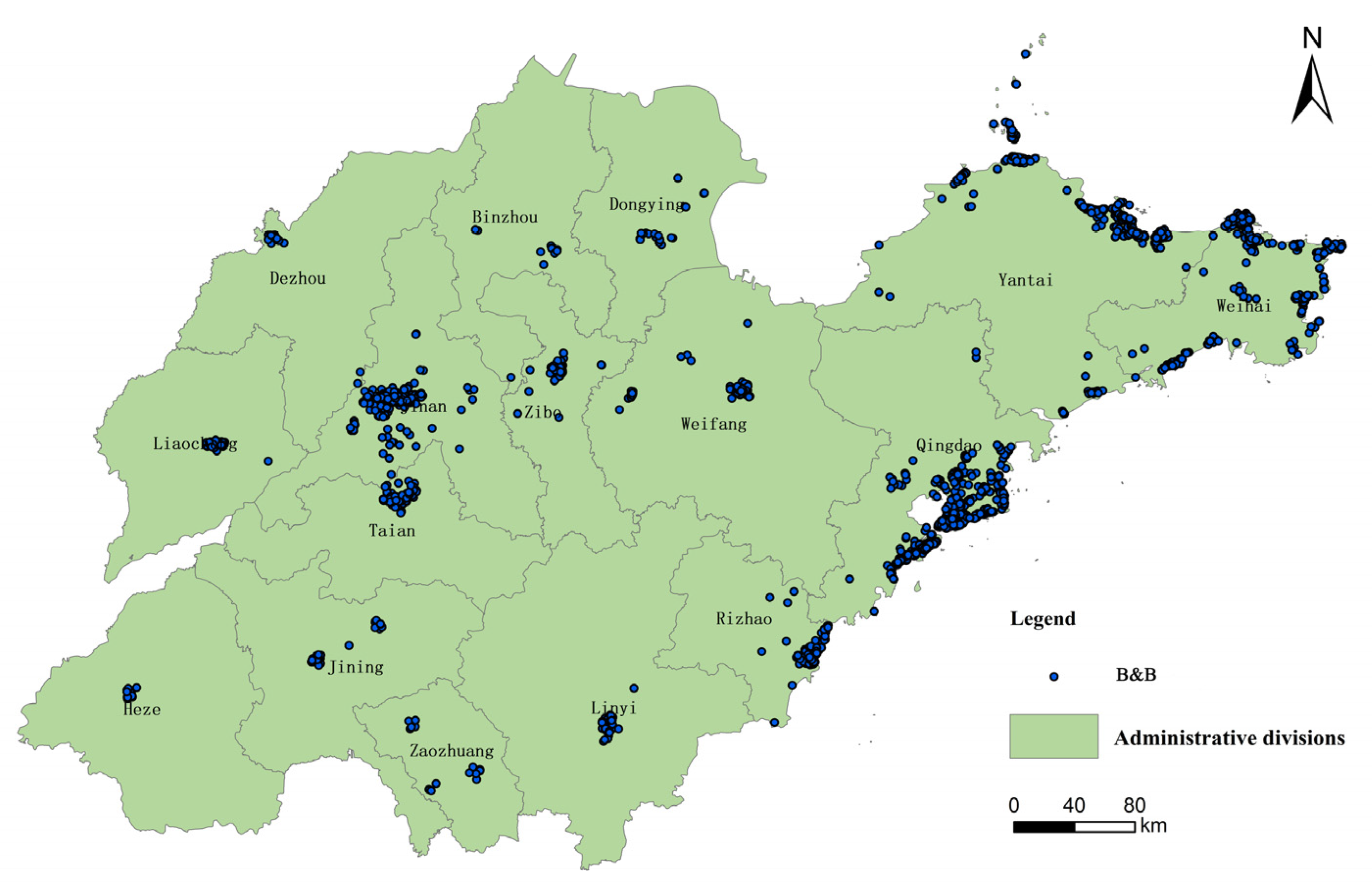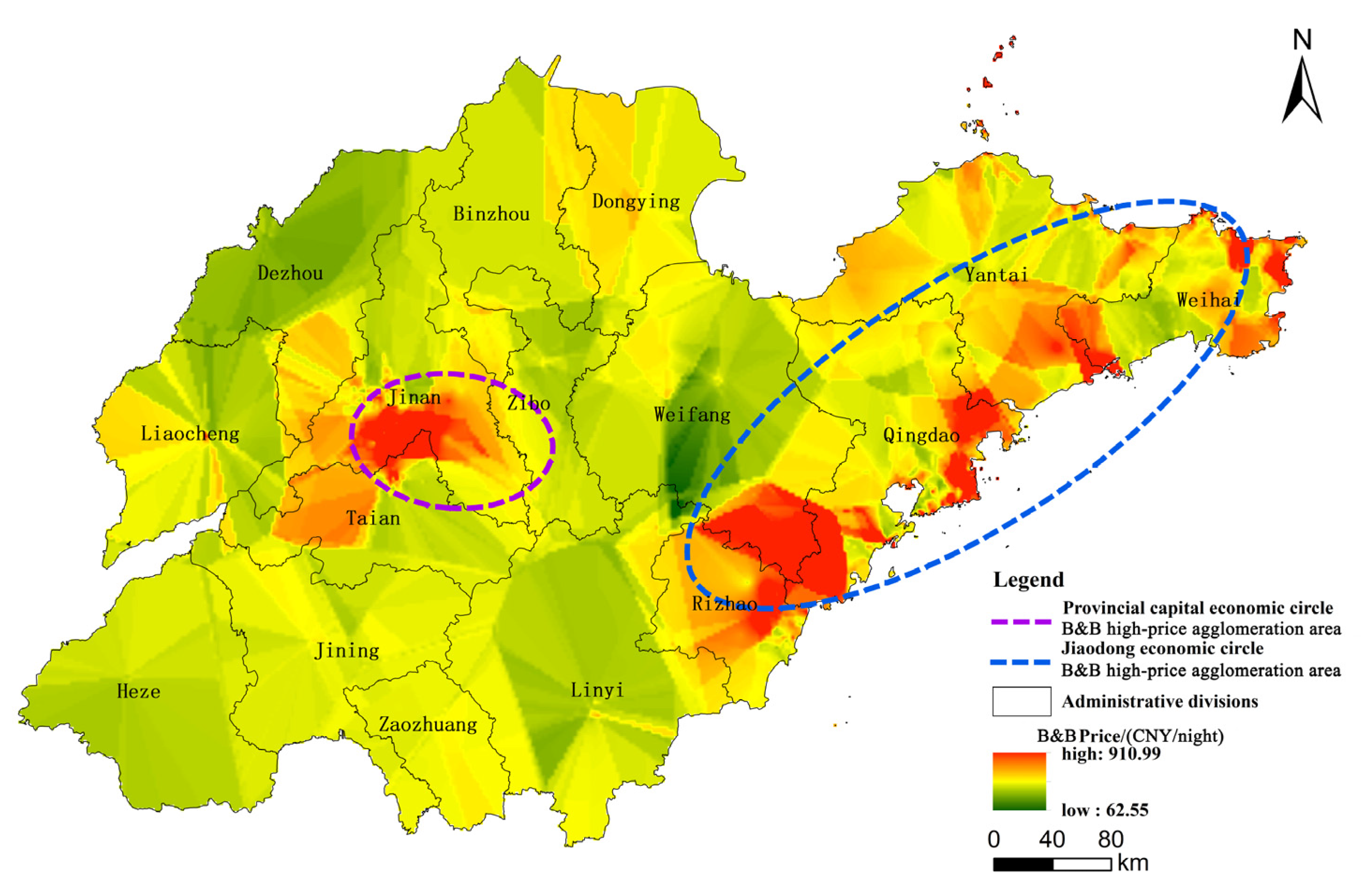The Impact on Bed and Breakfast Prices: Evidence from Airbnb in China
Abstract
:1. Introduction
2. Data and Methods
2.1. Study Area
2.2. Data Source
2.3. Methods
2.3.1. Global Spatial Autocorrelation Analysis
2.3.2. Empirical Bayesian Kriging Interpolation
2.3.3. Quantile Regression
3. Analysis and Discussion of Results
3.1. Analysis of Spatially Divergent Characteristics of B&B Prices in the Shandong Province
3.1.1. B&B Price Space Autocorrelation Analysis
3.1.2. Analysis of the Spatial Differentiation Pattern of B&B Prices
- (1)
- The Prices of B&Bs in the Shandong province Show Spatial Agglomeration
- (2)
- B&B Price High-Value Group Distribution is a “Two Circles” New Pattern
- (3)
- The Spatial Gradient Difference in the Low Value of B&B Prices is Obvious with the Clustering in the Northwestern and Southern Regions of Lu
3.2. Analysis of Factors Influencing the Prices of B&Bs in the Shandong Province
3.2.1. Analysis of the Results of the Factors Influencing the Prices of B&Bs from a Region-Wide Perspective
3.2.2. Analysis of the Results of the Factors Influencing the Prices of B&Bs from a Regional Perspective
4. Conclusions and Implications
4.1. Conclusions
4.2. Implications
Author Contributions
Funding
Institutional Review Board Statement
Informed Consent Statement
Data Availability Statement
Conflicts of Interest
References
- Guo, J.R. Blue Book of B&B: China Tourism B&B Development Report; Social Science Literature Publishing House: Beijing, China, 2019. [Google Scholar]
- Lu, S. Research on the Impact of Social Demand on the Transaction Price of Sharing Economy Platform. Master’s Thesis, Dalian University of Technology, Dalian, China, 2017. [Google Scholar]
- Wu, X.J.; Qiu, J.L. A study of factors influencing the price of Airbnb listings--based on data from 36 cities in China. Travel J. 2019, 34, 13–28. [Google Scholar]
- Hu, X.F.; Li, X.Y.; Zhao, H.M.; Deng, L.; Wang, T.Y. Spatially divergent characteristics and influencing factors of B&B prices--An example from Enshi Prefecture. Nat. Resour. 2020, 35, 2473–2483. [Google Scholar]
- Huang, H.P.; Lu, Y.C.; Jiang, H. Research on the pricing mechanism of scenic dependency B&B based on characteristic price model--the case of Shanghai Disney Resort. Geogr. Res. Dev. 2022, 41, 121–126. [Google Scholar]
- Wu, Q.; Yang, H.H. Research on the spatial differentiation of rural B&B prices and its influencing factors--an analysis based on the model of rural B&B price characteristics in Guizhou Province. Price Theory Pract. 2021, 11, 189–192. [Google Scholar]
- Chen, J.P.; Chen, J.; He, Y.D. Research on the factors influencing the price of B&B based on characteristic price model–Take Zhejiang Province as an example. Price Mon. 2021, 6, 20–26. [Google Scholar]
- Wang, D.; Nicolau, J.L. Price determinants of sharing economy based accommodation rental: A study of listings from 33 cities on Airbnb. Int. J. Hosp. Manag. 2017, 62, 120–131. [Google Scholar] [CrossRef] [Green Version]
- Jin, Y.; Yang, M.Z.; Guan, W.; Yao, J.L. Research on the spatial distribution characteristics of the price of residential accommodation in Hunan Province and its influencing factors. Geogr. Res. Dev. 2022, 41, 111–116. [Google Scholar]
- Long, F.; Dai, X.F.; Hu, Y. Spatial layout characteristics of Shanghai accommodation industry based on road network morphology. Geogr. Sci. 2021, 41, 1569–1577. [Google Scholar]
- Long, F.; Liu, J.M.; Zhu, H.; Li, T. Spatial distribution and influencing factors of B&B in the Yangtze River Delta. Geogr. Res. 2019, 38, 950–960. [Google Scholar]
- Shen, S.K.; Shi, C.Y. Spatial distribution characteristics of minshuku in southern Jiangsu and northern Zhejiang and its influencing factors. J. Trop. Geogr. 2022, 42, 123–135. [Google Scholar]
- Gibbs, C.; Guttentag, D.; Gretzel, U.; Morton, J.; Goodwill, A. Pricing in the sharing economy: A hedonic pricing model applied to Airbnb listings. J. Travel Tour. Mark. 2018, 35, 46–56. [Google Scholar] [CrossRef]
- Ma, X.B.; Hou, G.L.; Li, L.; Yang, Y. Identification, distribution pattern and influencing factors of B&B clusters based on DBSCAN algorithm–Nanjing city as an example. Hum. Geogr. 2021, 36, 84–93. [Google Scholar]
- Hong, X.T.; Zhang, H.M.; Zhang, Y.C. Willingness to use and usage behavior of Airbnb platform- an extension of the technology acceptance model. Geogr. Res. Dev. 2021, 40, 91–95+117. [Google Scholar]
- Wang, C.Y.; Chen, H.M. Research on accommodation prices and their influencing factors on shared short term rental platform--analysis based on relevant data from piggy short term rental website. Price Theory Pract. 2018, 6, 14–17. [Google Scholar]
- Solano-Sánchez, M.Á.; Santos, J.A.C.; Custódio Santos, M.; Fernández-Gámez, M.Á. Holiday Rentals in Cultural Tourism Destinations: A Comparison of Booking.com-Based Daily Rate Estimation for Seville and Porto. Economies 2021, 9, 157. [Google Scholar] [CrossRef]
- Santos, J.A.C.; Fernández-Gámez, M.Á.; Solano-Sánchez, M.Á.; Rey-Carmona, F.J.; López del Rio, L.C.Y. Valuation Models for Holiday Rentals’ Daily Rates: Price Composition Based on Booking. Sustainability 2021, 13, 292. [Google Scholar] [CrossRef]
- Niu, R.X.; He, Y. Research on the factors influencing the price of shared accommodation platform room listings based on characteristic price model. Bus. Econ. 2020, 39, 27–36. [Google Scholar]
- Shang, T.C.; Zhang, K.; Liu, P.H.; Li, X.X.; Shang, K.T.A. study on the factors influencing room prices of star-rated hotels in China. J. Tianjin Univ. 2015, 17, 301–305. [Google Scholar]
- Hung, W.T.; Shang, J.K.; Wang, F.C. Pricing determinants in the hotel industry: Quantile regression analysis. Int. J. Hosp. Manag. 2010, 29, 378–384. [Google Scholar] [CrossRef]
- Thrane, C. Examining the determinants of room rates for hotels in capital cities: The Oslo experience. J. Revenue Pricing Manag. 2007, 5, 315–323. [Google Scholar] [CrossRef]
- Chen, C.F.; Rothschild, D.R. An Application of Hedonic Pricing Analysis of the Case of Hotel Rooms in Taipei. Tour. Econ. 2010, 16, 685–694. [Google Scholar] [CrossRef] [Green Version]
- Espinet, J.M.; Saez, M.; Coenders, G.; Fluvià, M. Effect on Prices of the Attributes of Holiday Hotels: A Hedonic Prices Approach. Tour. Econ. 2003, 9, 165–177. [Google Scholar] [CrossRef]
- Xu, D.M.; Li, X.; Zhang, S.W. Study on the spatial differentiation pattern of housing prices in Shenyang and its influencing factors. Hum. Geogr. 2021, 36, 125–134. [Google Scholar]
- Qin, J.L.; Sheng, Y.H.; Wang, Y.F.; He, Y.F. Analysis of factors influencing residential prices in Nanjing. J. Earth Inf. Sci. 2021, 23, 882–890. [Google Scholar]
- Lu, C.W.; Zhang, M.; Jiang, S.; Wu, J.H. Spatial distribution characteristics and influencing factors of residential prices in Xi’an. Surv. Mapp. Sci. 2018, 43, 60–66. [Google Scholar]
- Zhao, J.M.; Zhu, D.L.; Li, Y.Y. Research on spatial differentiation of urban residential land prices and influencing factors based on new data--Zhengzhou City as an example. Mod. Urban Res. 2022, 3, 112–118. [Google Scholar]
- Benitez-Aurioles, B. Why are flexible booking policies priced negatively? Tour. Manag. 2018, 67, 312–325. [Google Scholar] [CrossRef]
- Lawani, A.; Reed, M.R.; Mark, T.; Zheng, Y. Reviews and price on online platforms: Evidence from sentiment analysis of Airbnb reviews in Boston. Reg. Sci. Urban Econ. 2019, 75, 22–34. [Google Scholar] [CrossRef]
- Ren, P.; Hong, B.T.; Zhou, J.M. Study on spatial and temporal evolution patterns and characteristics of rural settlements based on spatial autocorrelation model. Yangtze River Basin Resour. Environ. 2015, 24, 1993–2002. [Google Scholar]
- Zhou, C.; Jin, C.; Zhao, B.; Zhang, F. Study on inter-provincial spatial differences of regional economic-ecological-tourism coupling coordinated development. Arid. Zone Resour. Environ. 2016, 30, 203–208. [Google Scholar]
- Guo, J.P.; Feng, Z.W.; Chen, H.; Chen, Z.R.; Liu, S.X.; Wu, R.H.; He, J.F.; Li, H.C. Spatial and temporal price changes and driving mechanisms in the high-end residential market in Beijing—Taking Sunhe Township as an example. Geogr. Res. Dev. 2020, 39, 64–69. [Google Scholar]
- Me, C.X.; Lai, X. Spatial structure of residential prices in Dongguan City based on ESDA and Kriging methods. Econ. Geogr. 2008, 5, 862–866. [Google Scholar]
- Kuntz, M.; Helbjch, M. Geostatistical mapping of real estate prices: An empirical comparison of kriging and cokriging. Int. J. Geogr. Inf. Sci. 2014, 28, 1904–1921. [Google Scholar] [CrossRef]
- Zhang, Z.Y.; Sun, G.Y.; Yang, C.; Zhou, Y.H. Analysis of heterogeneous policy effects- a new regression method for conditional quantile of dependent variable and its application. J. Econ. Res. 2021, 56, 177–190. [Google Scholar]
- Zhang, Z.; Chen, R.J.C.; Han, L.D.; Yang, L. Key Factors Affecting the Price of Airbnb Listings: A Geographically Weighted Approach. Sustainability. 2017, 9, 1635. [Google Scholar] [CrossRef]



| Feature Classification | Explanatory Variables | Variable Description | Variable Assignment | Average Value | Standard Deviation |
|---|---|---|---|---|---|
| Dependent variable | Price | Price per room per night on Airbnb (CNY) | According to the collected data | 213.70 | 148.70 |
| Location Features | Provincial roads | The distance of the B&B from the provincial road Distance (m) | According to ArcGIS calculation results | 3811.00 | 2908.00 |
| National highway | The distance of the B&B from the provincial road Distance (m) | According to ArcGIS calculation results | 7292.00 | 5953.00 | |
| Scenic Area | Distance of B&B from the nearest scenic spot above 4A levels (m) | According to ArcGIS calculation results | 3884.00 | 4262.00 | |
| Downtown | Distance of B&B from city center Distance (m) | According to ArcGIS calculation results | 16,855.00 | 22,889.00 | |
| Architectural Features | Accommodation space | Accommodation space per room Number (rooms) | According to the collected data | 2.94 | 1.70 |
| Garden | With or without garden | Dummy variable, 1 or 0 | 0.05 | 0.22 | |
| Terrace | Whether it has a terrace or not | Dummy variable, 1 or 0 | 0.02 | 0.12 | |
| Service Features | Awesome Landlord | Labeling according to certain rules of the platform | Dummy variable, 1 or 0 | 0.41 | 0.49 |
| Cancellation Policy | Flexible and timely cancellation policy | Dummy variable, 1 or 0 | 0.40 | 0.49 | |
| Free parking | Free parking space | Dummy variable, 1 or 0 | 0.61 | 0.49 | |
| Reputation Features | Rating | Guest Ratings | According to the collected data | 2.96 | 2.35 |
| Number of Comments | Number of Guest Reviews | According to the collected data | 11.30 | 21.16 |
| Variables | OLS | 0.1 | 0.25 | 0.5 | 0.75 | 0.9 |
|---|---|---|---|---|---|---|
| Constants | 266.756 *** | 122.255 *** | 158.677 *** | 204.660 *** | 295.689 *** | 458.564 *** |
| Provincial Roads | −3.437 *** | −0.001 *** | −0.002 *** | −0.003 *** | −0.005 *** | −0.006 *** |
| National Highway | 2.146 *** | 0.000 ** | 0.001 *** | 0.002 *** | 0.003 *** | 0.005 *** |
| Scenic Area | −2.874 *** | −0.001 *** | −0.001 *** | −0.001 *** | −0.003 *** | −0.005 *** |
| Downtown | −0.000 *** | −0.000 | −0.000 | −0.000 *** | −0.000 *** | −0.001 *** |
| Accommo-dation Space | 9.928 *** | 9.887 *** | 12.926 *** | 12.731 *** | 8.671 *** | 7.222 * |
| Garden | −16.965 *** | −17.170 *** | −19.788 *** | −12.731 *** | −15.641 *** | −21.419 *** |
| Terrace | 56.671 *** | 27.592 *** | 35.107 *** | 60.187 *** | 99.079 *** | 131.387 *** |
| Superb Landlord | −13.262 *** | −1.182 | −4.160 | −5.815 *** | −14.247 ** | −26.312 ** |
| Cancellati On Policy | −11.767 *** | −4.253 *** | 0.221 | −3.970 *** | −11.639 *** | −35.777 *** |
| Free Parking | −28.058 *** | −17.144 *** | −21.826 *** | −24.584 *** | −32.710 *** | −42.588 *** |
| Rating | −4.278 *** | −0.111 | −0.502 ** | −1.135 *** | −4.963 *** | −12.534 *** |
| Number of Comments | −0.223 *** | −0.024 | −0.045 | −0.164 *** | −0.283 *** | −0.181 |
| Observatio-ns | 9268.000 | 9268.000 | 9268.000 | 9268.000 | 9268.000 | 9268.000 |
| Main Influencing Factors | Jiaodong Economic Circle | Provincial Capital Economic Circle | Northwest Lu and South Lu Regions |
|---|---|---|---|
| Rizhao, Weifang, Qingdao, Yantai, Weihai | Jinan, Tai’an | Liaocheng, Dezhou, Binzhou. Dongying, Heze, Jining. Zaozhuang, Linyi, Zibo | |
| Provincial Roads | (-) | (-) | |
| National Highway | (+) | (+) | |
| Scenic Area | (+) | ||
| Downtown | (-) | (+) | |
| Accommodation space | (+) | (+) | (+) |
| Garden | (-) | ||
| Terrace | (+) | (+) | |
| Superb landlord | (-) | (-) | (-) |
| Cancellation Policy | (-) | (-) | |
| Free Parking | (-) | (-) | (-) |
| Rating | (-) | (-) | (-) |
| Number of Comments | (-) | (+) | (+) |
Publisher’s Note: MDPI stays neutral with regard to jurisdictional claims in published maps and institutional affiliations. |
© 2022 by the authors. Licensee MDPI, Basel, Switzerland. This article is an open access article distributed under the terms and conditions of the Creative Commons Attribution (CC BY) license (https://creativecommons.org/licenses/by/4.0/).
Share and Cite
Tian, F.; Sun, F.; Hu, B.; Dong, Z. The Impact on Bed and Breakfast Prices: Evidence from Airbnb in China. Sustainability 2022, 14, 13834. https://doi.org/10.3390/su142113834
Tian F, Sun F, Hu B, Dong Z. The Impact on Bed and Breakfast Prices: Evidence from Airbnb in China. Sustainability. 2022; 14(21):13834. https://doi.org/10.3390/su142113834
Chicago/Turabian StyleTian, Feifei, Fengzhi Sun, Beibei Hu, and Zhitao Dong. 2022. "The Impact on Bed and Breakfast Prices: Evidence from Airbnb in China" Sustainability 14, no. 21: 13834. https://doi.org/10.3390/su142113834
APA StyleTian, F., Sun, F., Hu, B., & Dong, Z. (2022). The Impact on Bed and Breakfast Prices: Evidence from Airbnb in China. Sustainability, 14(21), 13834. https://doi.org/10.3390/su142113834





